01 Cell Wall And Membrane
Penicillin
Ringed planet: beta-lactam ring
Death Coccus wall: peptidoglycan cell wall with repeating D-alanyl- D-alanine oligopeptides
Planetary Building Project worker: penicillin binding protein (PBP) forms peptidoglycan cross-links
Inactivated PBP worker: beta-lactam antibiotics covalently bind PBPs → the space worker
Bacterialcidal

This particular group is characterized by its four-membered, nitrogen-containing beta-lactam ring at the core of their structure, which is key to the mode of action of this group of antibiotics.
PBPs are all involved in the final stages of the synthesis of peptidoglycan
Purple pencil: penicillin

Purple coccoid space stations: activity against gram positive organisms (e.g. Staph and Strep)
Red bandana: penicillin V treats streptococcal pharyngitis
Heart-shaped planet Sydenhaam: penicillin V or G treats rheumatic fever
Emperor Viridans: Strep viridans
Bicuspid hat: penicillin G treats left-sided endocarditis caused by Strep viridans and Strep bovis
A galactic baby: intrapartum penicillin G prophylaxis for Group B strep (Strep agalactiae)
Israeli flag: activity against Actinomyces israelii
Perforated spacesuit: activity against Clostridium perfringens
Space dog: activity against Pasteurella multocida infected dog bite wounds
Red gloves and boots: single dose of benzathine penicillin G treats Syphilis (Treponema pallidum)
Meningitis mohawk: penicillin G treats Neisseria meningitidis..

V-winged ship: penicillin V
Acid nebula: oral penicillin V is acid stable
Royal G-shaped hairdo: penicillin G
Ivy: penicillin G administered IV..

Beta guard: beta-lactamase resistance
Circular shape: beta-lactamases expressed by plasmid genes..

IgE missiles: Type-1 (IgE mediated) hypersensitivity reaction
Exploding asteroids: drug-induced autoimmune hemolytic anemia
IgG missile on surface: positive direct Coombs test
Blue star clusters in kidney nebula: drug-induced interstitial nephritis..
Nafcillin, oxacillin, methicillin & dicloxacillin
Protective armor: bulky R-groups prevent beta-lactamase binding.,
Staff pencil: nafcillin
Ox horns: oxacillin
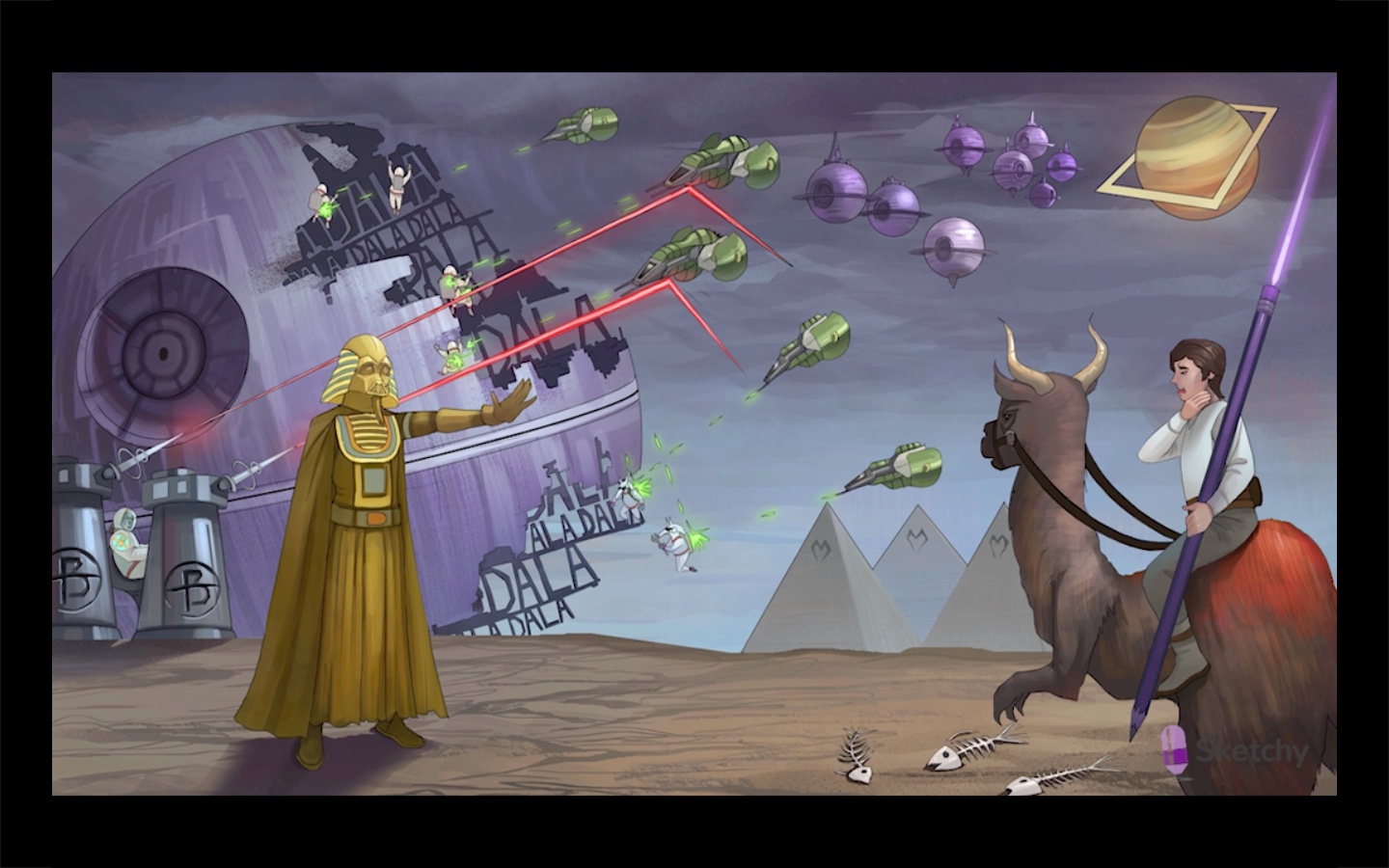

Red hump: empiric treatment for skin and soft tissue infections (e.g. folliculitis, abscesses)
Tricuspid pyramids: treats Staph endocarditis
Fish bones: treats Staph osteomyelitis

Altered wall builder: altered penicillin binding proteins (PBPs) resistant to beta-lactam
Merciless dark lord MRSA: methicillin resistant Staph aureus (MRSA)
Ampicillin, amoxicillin, piperacillin, ticarcillin
Piper: piperacillin
Tiger stripes: ticarcillin
Amp: ampicillin
Ammo box: amoxicillin
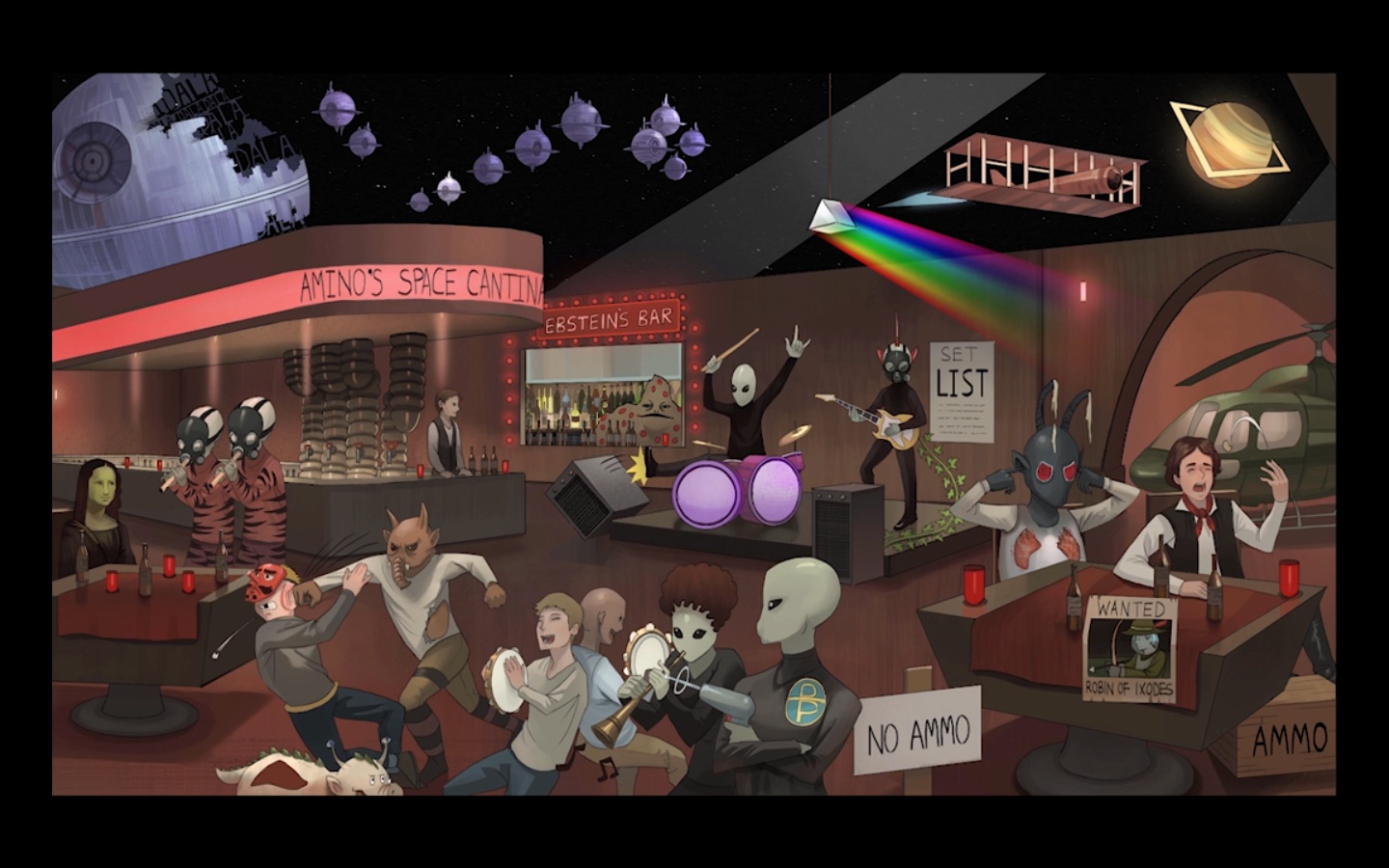
Red color: improved activity against gram negative bacteria
Prism: broad spectrum
Still binds PBP via beta lactam

Open mouth: amoxicillin - oral bioavailability
Ivy: ampicillin - IV administration

Space stations: staph, strep
Red bandana: amoxicillin and ampicillin treat streptococcal pharyngitis
Plugged ears: amoxicillin treats otitis media and sinusitis caused by Strep pneumoniae, Haemophilus influenzae, Moraxella catarrali
Rusty chest plate: amoxicillin and ampicillin treat pneumonia caused by Strep pneumoniae, Haemophilus influenzae
H wing ship: activity against Haemophilus influenzae
Helicopter: amoxicillin is part of the triple therapy (with clarithromycin and a PPI) for Helicobacter pylori infection
Robin of Ixodes: amoxicillin treats Lyme disease caused by Borrelia burgdorferi
Spleen hole: amoxicillin prophylaxis against encapsulated bacteria (e.g. Strep pneumoniae and Haemophilus influenzae) in asplenic patients
Amoxicillin prophylaxis before dental procedures in patients at high risk for endocarditis
Ampi:
Diplococcus rock drums: ampicillin treats Enterococcus infections
Set list: ampicillin treats meningitis caused by Listeria monocytogenes
Activity against gastrointestinal and urinary tract gram negative rods (e.g. E coli)
Also some GI bugs

Knocked over amp: ampicillin resistant strains of Enterococcus due to beta-lactamase production
Beta bouncer: sensitivity to beta-lactamases
To counter resistance:
Distracting clarinet: clavulanate - beta-lactamase inhibitor
Back to back tambourines: tazobactam and sulbactam - beta- lactamase inhibitors

Trampled liver spot: drug induced liver injury
Red lights: antibiotic induced rash in the setting of viral illness (e.g. Epstein-Barr virus -infectious mononucleosis)

Gas mask: piperacillin and ticarcillin treat anaerobic infections
Mona Lisa: piperacillin and ticarcillin treat Pseudomonas infections
Cephalosporin
Activity goes from gram positive to gram negative
Binds PBP
Ineffective beta lasers: Beta lactamase ineffective
1st Gen
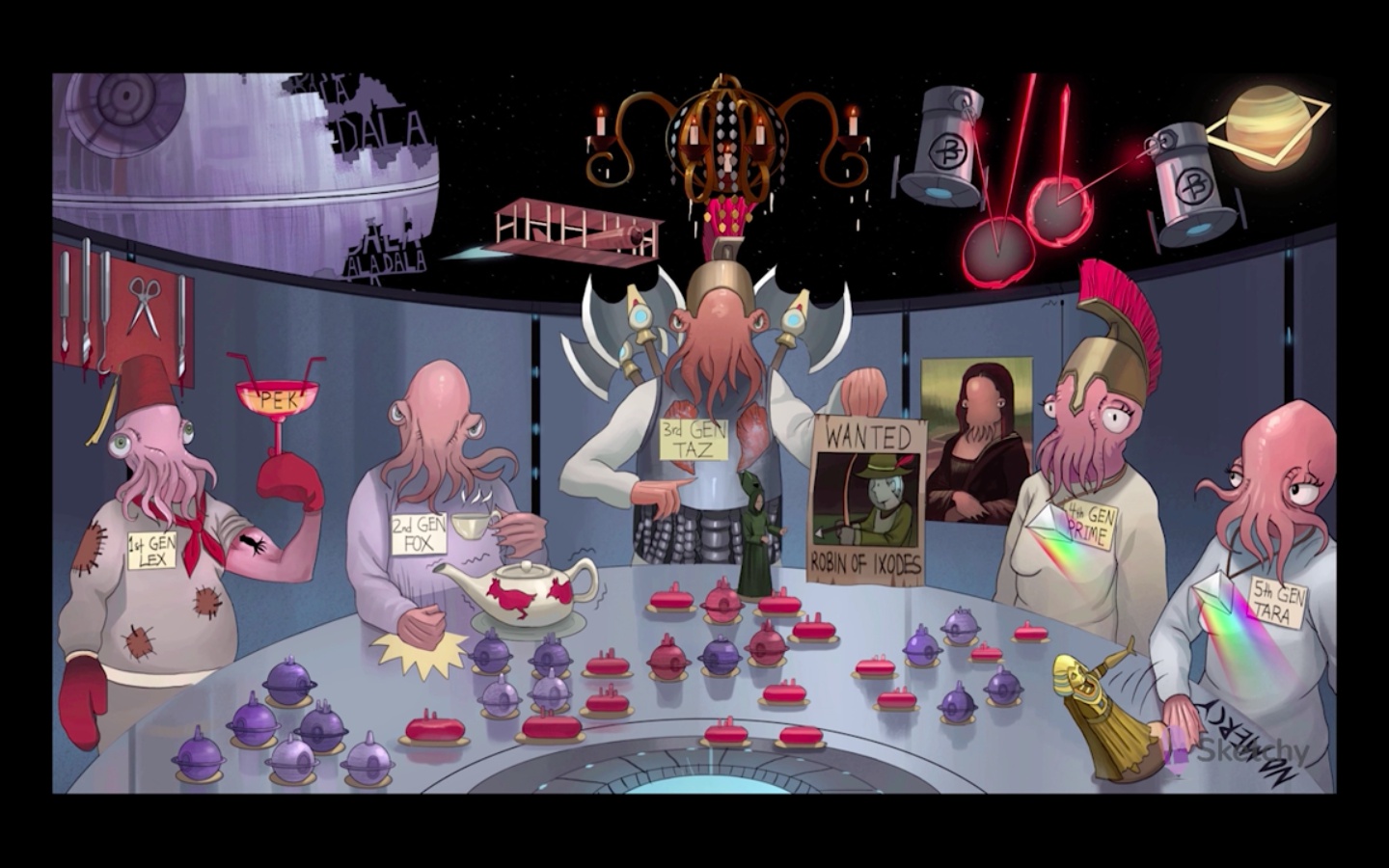
1st General Lex: 1st generation cephalosporins include cephalexin and cefazolin
Flex: cephalexin
Fez: cefazolin

Purple coccoid space stations: activity against gram positive organisms (e.g. Staph and
Strep) (1st gen)
Puffy red gloves and patches: treats cellulitis, abscesses caused by Staph and Strep (1st
gen)
Red bandana: treats Strep pharyngitis (1st gen)
Red bladder cup: activity against gram negative UTI bugs (e.g. Proteus, E coli, Klebsiella)
surgical instruments: cefazolin for surgical prophylaxis
2nd Gen

2nd General Fox: 2nd generation cephalosporins include cefuroxime, cefotetan, cefoxitin
Furious: cefuroxime
Tea cup: cefotetan
Fox: cefoxitin

Some red space stations: same coverage as 1st gen with extended gram negative coverage
Red hens: activity against Haemophilus influenzae, Neisseria, Serratia (HENS)
3rd Gen

3rd General Taz: 3rd generation cephalosporins include ceftriaxone, cefotaxime, and ceftazidim
3 axes: ceftriaxone and cefotaxime
Taz: ceftazidime

Mostly red space stations: extended gram negative coverage beyond 2nd gen
Mohawk helmet: empiric treatment for meningitis (3rd gen)
H-wing ship: activity against Haemophilus influenzae
Rusty chest plate: treats community and hospital acquired pneumonia
Mona Lisa: ceftazidime treats Pseudomonas infections
Emperor Viridans: ceftriaxone treats endocarditis caused by Strep viridans and HACEK organisms
Activity against gram negative GI bugs (e.g. Salmonella, Shigella)
Dripping chandelier: single dose of IM ceftriaxone is first line treatment for gonorrhea
Robin of Ixodes: ceftriaxone treats Lyme disease caused by Borrelia burgdorferi
4th Gen

4th General Prime: 4th generation cephalosporins include cefepime

Prism: broad spectrum
Mona Lisa: Pseudomonas
Red and purple space stations: broad spectrum (4th gen)
Mohawk helmet: cefepime treats bacterial meningitis
5th Gen

5th General Tara: 5th generation cephalosporins include ceftaroline

Prism: broad spectrum
Lord MRSA: ceftaroline treats MRSA infections
Monobactam and Carbopenem
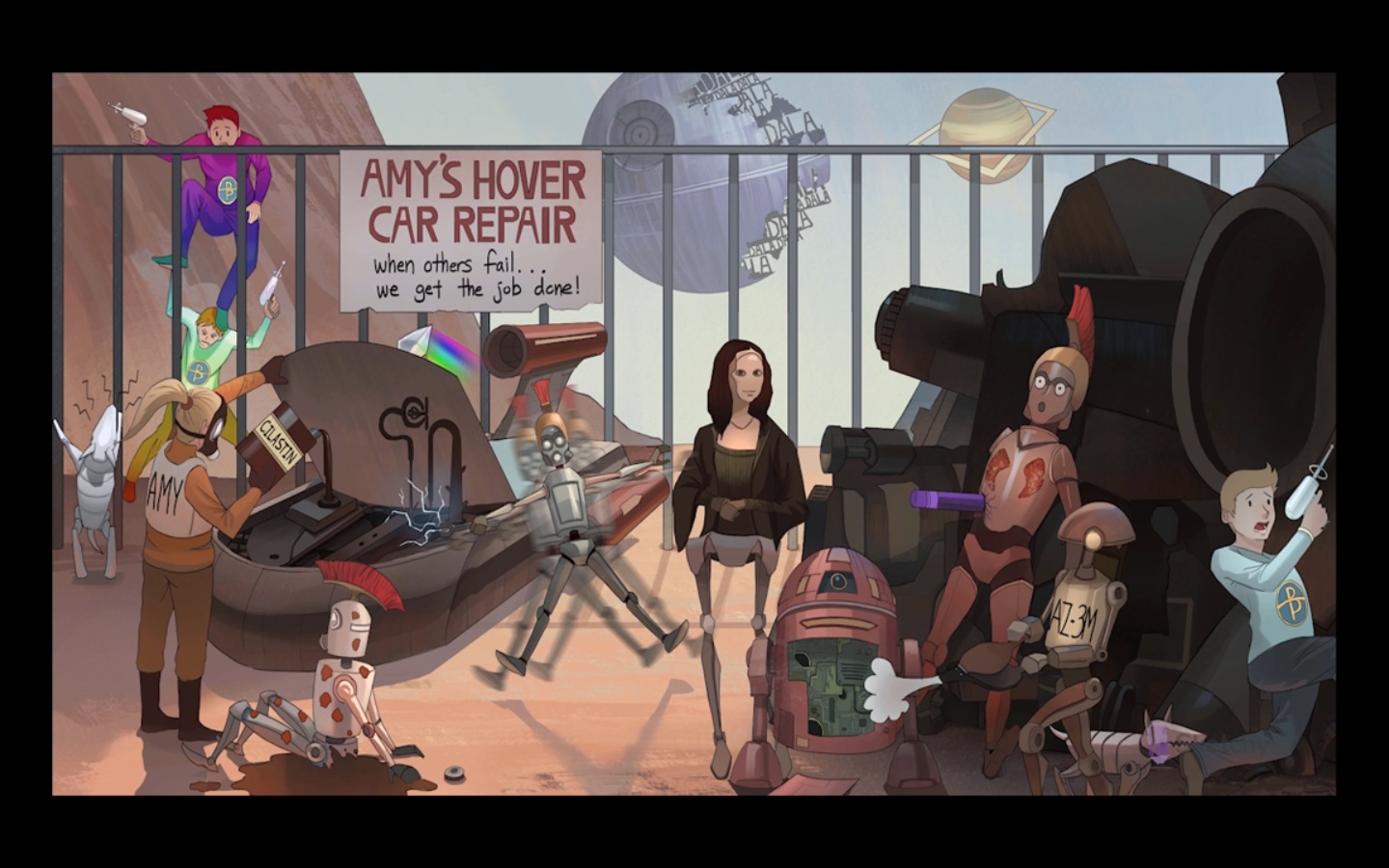
Ringed planet: beta-lactam ring
Unfinished Death Coccus: binds PBPs halting peptidoglycan wall synthesis

One eyed AZ-3M: monobactam - aztreonam
One eyed android: Monobactam has single beta lactam ring
Bellows: monobactam has activity against aerobic gram negative rods
Red rod robot: monobactam has activity against aerobic gram negative rods
Ineffective beta guard: monobactams are resistant to beta- lactamases
Activity only against gram negative and aerobic

Mona Lisa: monobactams and carbapenems treat Pseudomonas infections
Red mohawk helmet and rusty lungs: monobactam treats serious systemic infections with gram negative pathogens (e.g. meningitis, pneumonia, sepsis)
Pencil wound: monobactams can be used in patients with a h/o penicillin allergy

Hover car: carbapenems - imipenem, ertapenem, meropenem, doripenem
prism: carbapenems are broad spectrum
gas mask: carbapenems treat anaerobic infections (e.g. pneumonia, intra-abdominal infections)
ineffective rainbow beta guard: monobactams are resistant to extended spectrum beta-
lactamases

“when others fail”: use carbapenems with bugs resistant to other available treatments
mohawk helmet: carbapenems treat bacterial meningitis

Amy: imipenem

Cilastin oil: cilastin inhibits dehydropeptidase in renal tubules preventing the degradation of imipenem

Mud puddle: GI side effects of carbapenems
Rust spots: carbapenem may cause skin rash
Shaking: imipenem lowers the seizure threshold
Vancomycin
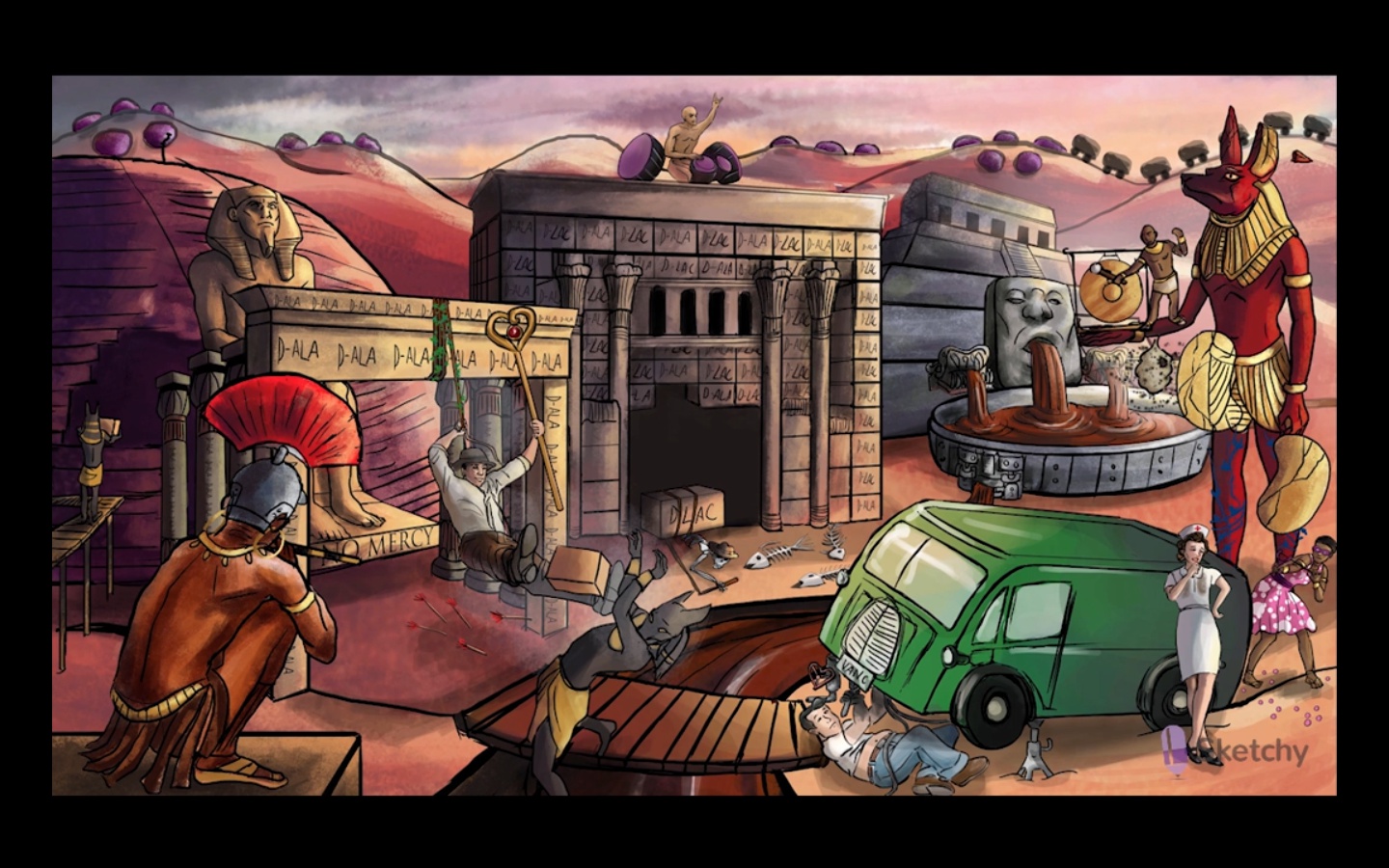
Purple coccoid temples: activity against gram positive bacteria (e.g. Staph, Strep)
Ivy: IV administration

Altered wall builder: altered penicillin binding proteins (PBPs) resistant to beta-lactams like penicillin
Temple wall hieroglyphs: inhibition of cell wall synthesis by directly binding D-alanyl-D-
alanine oligopeptides
Ineffective altered wall builder: altered PBPs ineffective against vancomycin
Shooting arrows: vancomycin resistanct to beta lactamase

Golden staff: Staph aureus
No mercy pharaoh: activity against methicillin resistant Staph aureus (MRSA)
Meningitis mohawk: CNS penetration - activity against penicillin- resistant Strep pneumo (PRSP)
Fish bones: bone penetration - treats MRSA osteomyelitis
Nurse: activity against nosocomial MRSA infections (e.g. hospital acquired pneumonia)
Biofilm on lines and valves: activity against Staph epidermidis
heart shaped headpiece: empiric treatment of endocarditis
Diplococcus rock drums: activity against Enterococcus
Temple of flowing chocolate: oral vancomycin treats Clostridium difficile colitis

D-LAC hieroglyph: altered peptidoglycan structure (D-ALA-D-LAC) confers resistance to vancomycin
Vancomycin is frequently used synergistically with aminoglycosides for treatment of penicillin-resistant enterococcal infections. Vancomycin resistance (mediated by plasmids or transposons) can develop when bacterial proteins serving as ligases alter the D-alanyl D-alanine cell wall precursors, which are the targets of vancomycin. VanA ligase replaces D-alanyl D-alanine with D-alanine D-lactate, thereby preventing vancomycin binding.

Red statue: red man syndrome due to histamine release
Beehive: mast cell
Blue vines: thrombophlebitis
Broken ear: ototoxicity
Falling kidney: nephrotoxicity
Slingshot native in dress: Drug reaction with eosinophilia and systemic symptoms (DRESS syndrome)
Undulating sand dunes: monitor plasma levels
Daptomycin
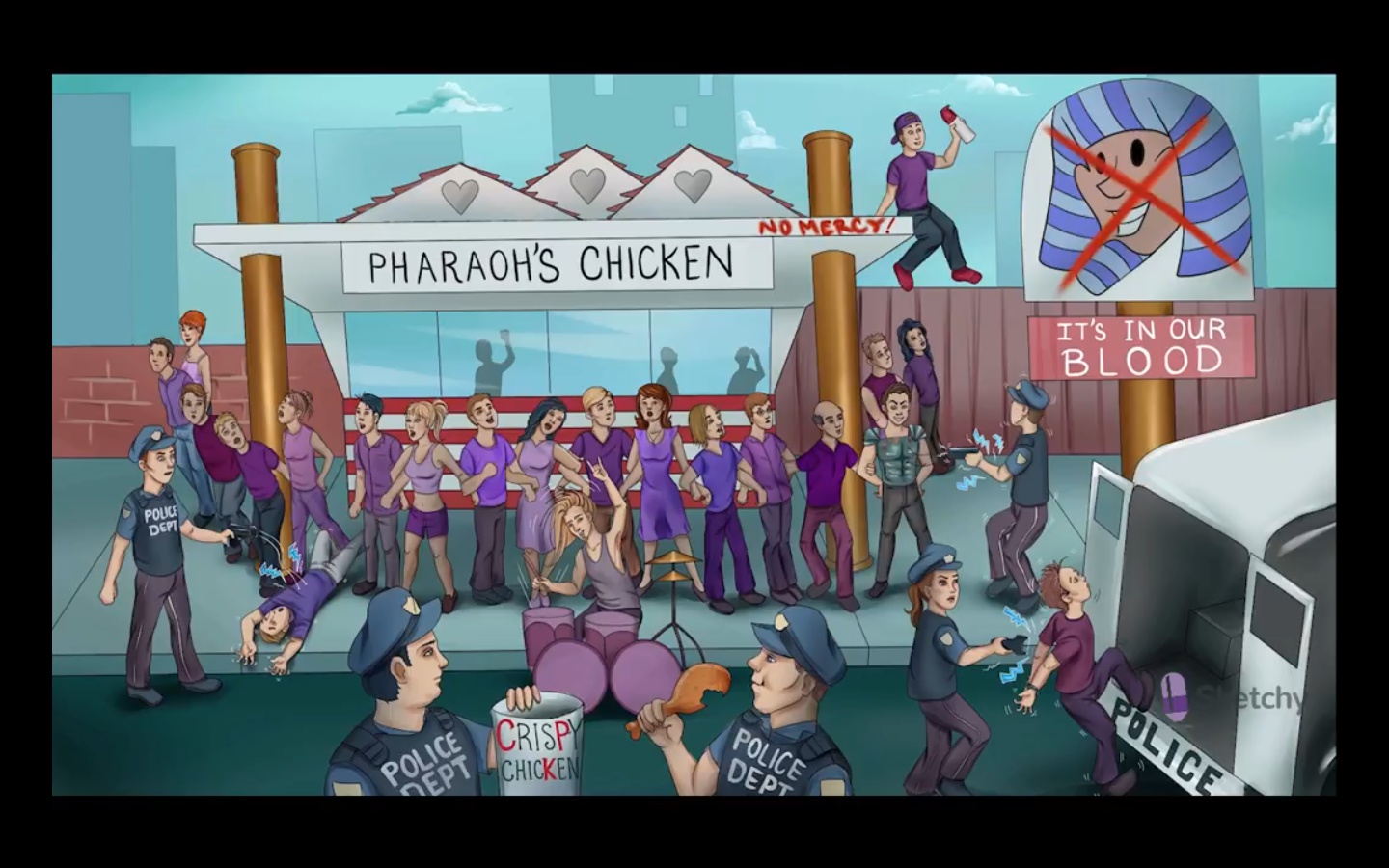
POLICE DEPT: DAPTomycin
Purple wall of protesters: activity against gram positive cell wall (e.g. Staph, Strep, Enterococcus)
Taser: inserts lipid tail into membrane to depolarize cell
Resisting van: activity against vancomycin resistant bacterial strains
Diplococcus rock drums: activity against Enterococcus
No mercy pharaoh: activity against methicillin resistant Staph aureus (MRSA)
“It’s in our blood”: treats MRSA bacteremia
Tricuspid peaks: treats Staph endocarditis
Protective rusty chest plate: ineffective for pneumonia

Chicken leg bite: myopathy
CrisPy chicKen: monitor creatinine phosphokinase (CPK) levels
Last updated
Was this helpful?